Does a Pink Dolpine Live in the Rainforest Jaguar Baby
The Amazon river dolphin, pink dolphin or Boto is a freshwater dolphin. It inhabits South America, mainly in the Amazon river, but too in the Orinoco basin and Madeira river.
Then, what actually is a Pink Dolphin?
Pink dolphins (Inia geoffrensis) are a species of Toothed whales classified in the family Iniidae and it contains three sub-species: Amazon river dolphin (I. g. geoffrensis), Bolivian river dolphin (I. grand. boliviensis) and Orinoco river dolphin (I. g. humboldtiana).
They seem to have some human relationship with their South Asian counterparts, the Ganges river dolphin (P. g. gangetica), predominant in India, and Indus river dolphin (P. g. small-scale), predominant in Islamic republic of pakistan. The pinkish dolphin is the biggest of all river dolphins.
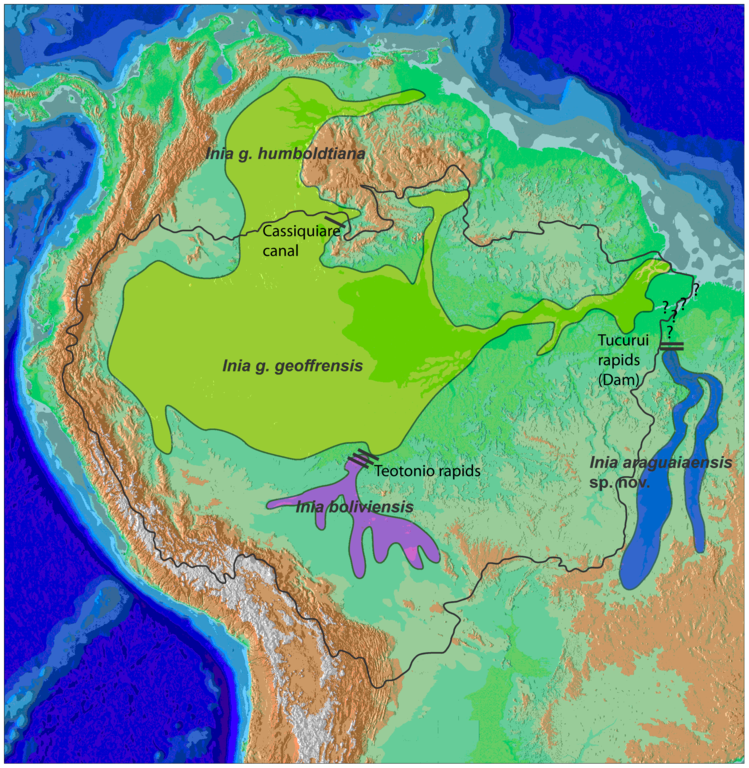
How does a Pink Dolphin await? Can you show me one?
With the developed males reaching an average length of 2.3 metres (seven.six ft) and an average weight of 150 kilograms (340 lb), and the females reaching a length and weight of 2 metres (6.6 ft) and average 100 kilograms (220 lb), they will not pass unseen by your side if you are navigating in their habitat. In contrast with other cetaceans, in this case, the male is bigger than the female person.
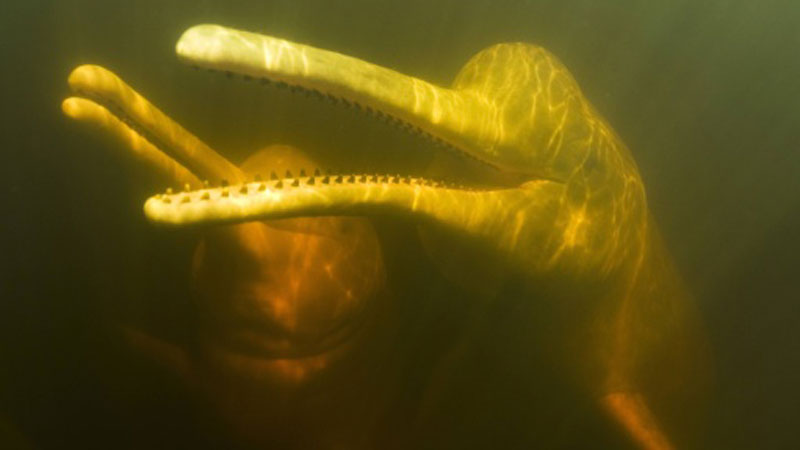
Their cervical vertebrae are not fused, allowing the caput to turn 90 degrees to each side. This, in conjunction with big pectoral fins, gives them very skilful maneuverability to swim through the flooded forest searching for their casualty. You can meet the way they swim and move in this video put up by National Geographic.
In his head we found quite a few interesting things, so for the ones of you lot digging this article for your homework, proceed reading!
They have small eyes, but skilful eyesight, in and out of the water. Between 25-28 pairs of teeth to each side of both jaws helps them capture fish, tortoises or venereal. It is curious tho, that they are the only toothed whales to have different types of teeth in their jaw. And finally, the melon on their heads, which they tin modify by muscular command for using it equally a Biosonar (or Animal echolocator)
Are Pink Dolphins really Pink?
Depends. The color of their bodies varies with age. Young dolphins have a dark gray colour, which in adolescence transforms into calorie-free gray. Adults tin brandish a range of colors from lite grayness to pink (varying from solid to mottled) and even chocolate-brown.
Information technology is not entirely clear why they accept this color just i of the strongest hypothesis says it's due to the repeated abrasion of the skin surface. Some observations correlate with this theory, for example, that males tend to be pinker than females (they fight more than between them, displaying intra-species aggression). Some other hypothesis, like the 1 of Tim Caro, mammal coloration practiced from the Academy of California at Davis, says that this coloration could be to match the particulate crimson mud that follows heavy rains in some rivers.
All in all, no ane knows for sure why.
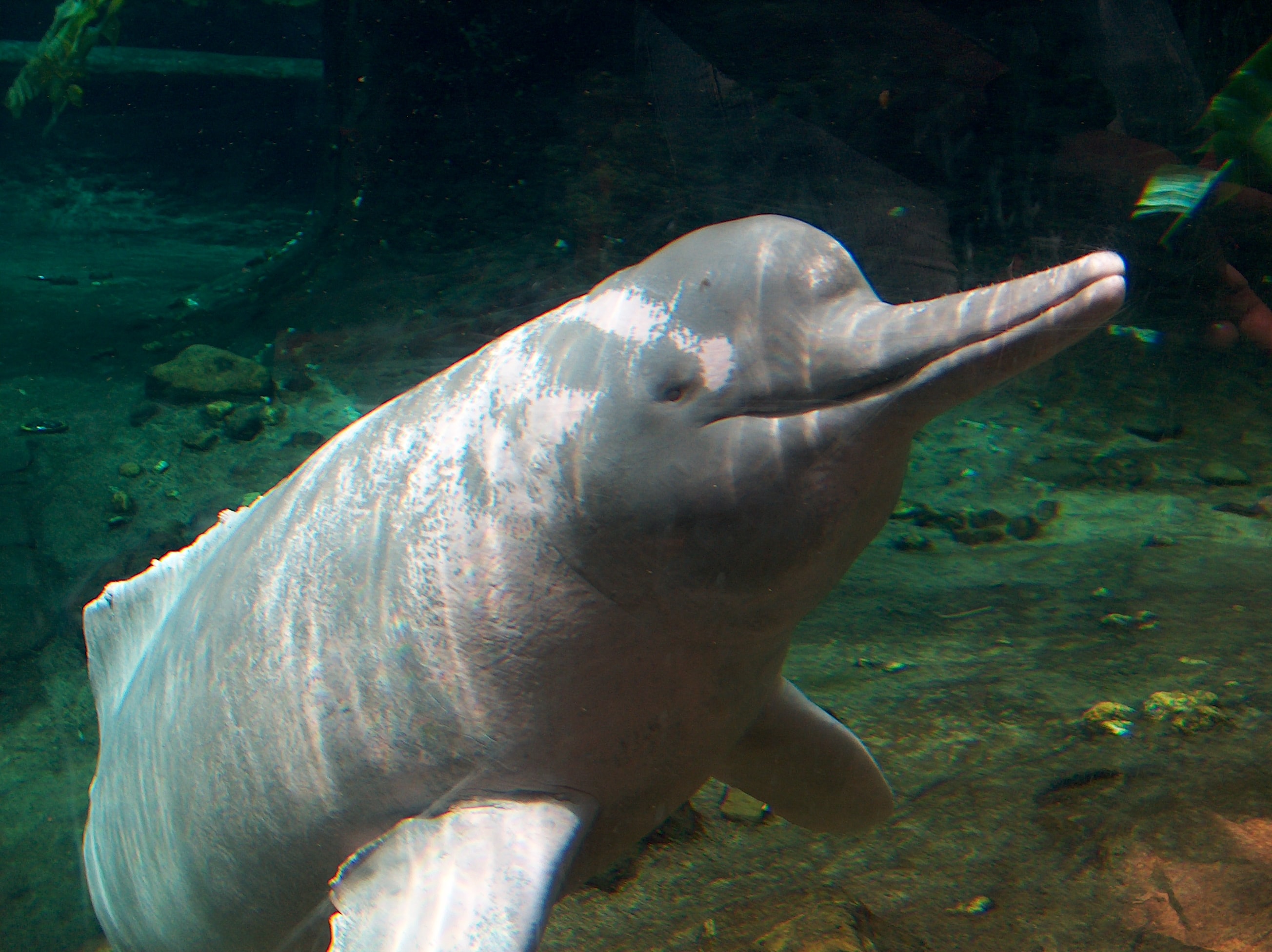
What do Pink Dolphins eat?
Basically, pink dolphins consume nearly anything minor that swims. They eat around fifty species of Amazon fishes, including piranhas. Turtles and venereal are likewise on the daily diet which consists of around 2.5% of its body weight every 24-hour interval.
Pink dolphins take a powerful jaw. The front row of teeth helps to puncture and to agree fishes (or other preys). The back row is for crushing and smashing.
After they grab their food pink dolphins swallow their food without chewing. All indigestible parts (like basic or spines) are regurgitated after.
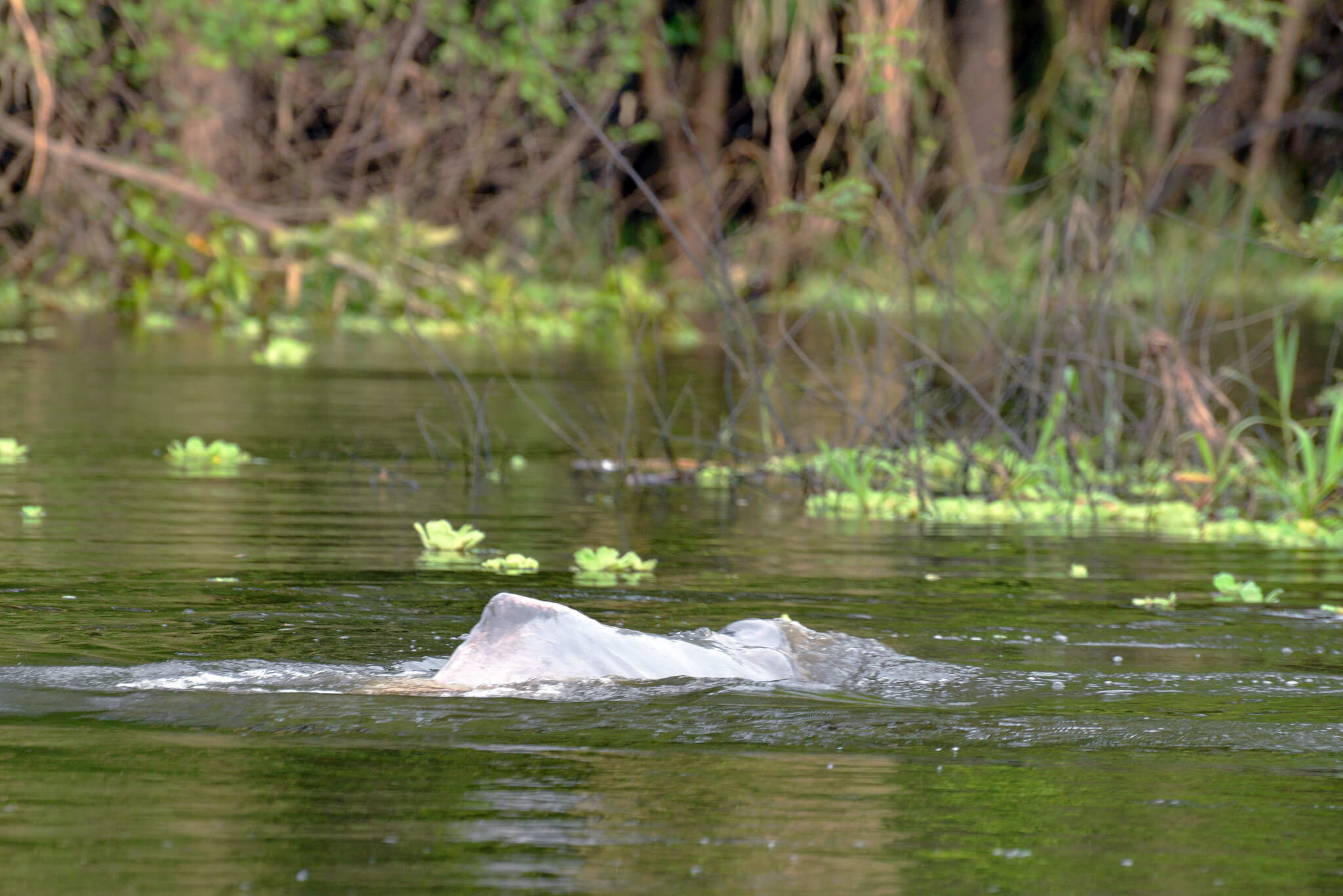
Are Pinkish Dolphins smart?
We might take heard that dolphins are very smart animals, but what kind of intelligence practice they take?
The answer is Cetacean intelligence.
They are aware of themselves and their different body parts, are able to experience basic emotions, appoint themselves in some degree of abstract idea and sympathise the construction of their surroundings. They learn by observing and even mimicking, solve problems and choose their own deportment, fifty-fifty remembering their own recent beliefs.
When interacting with humans, they appear to recognize the difference between children and adults and tend to exist more gentle and patient with children. Some researchers advise that dolphins are "non-human persons" who qualify for moral agreement as individuals.
There are no specific studies related to Pink dolphins and their intelligence, but being part of the same family we tin suppose that they share almost of their cognitive organisation.
For more in-depth information almost the brain power of dolphins (and whales) click hither
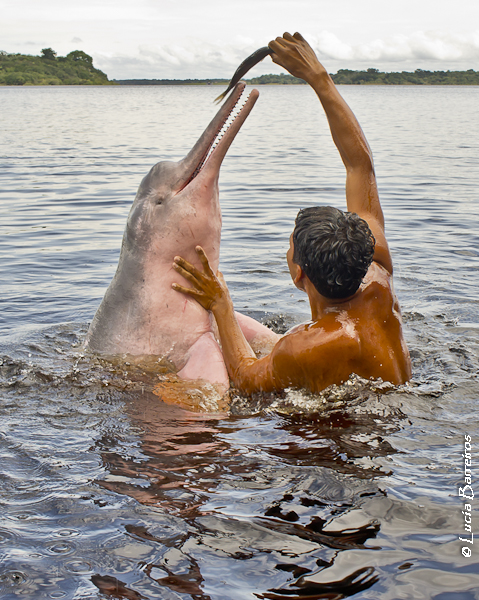
Are Pink Dolphins threatened or endangered now?
Aye, they are threatened past many factors such as the contamination of the river (with mercury, for instance, by the illegal mining operations) and the increased deforestation of the Amazon jungle that affects many unlike ecosystems changing the migration patterns of some fish species that they consume.
But the main threat to them is the hunting and deliberate killing along with their incidental capture in fishing gears. A big office of the income of riverside families that live in the Amazon is the fishing action, and dolphins are prone to harm fishing equipment when they go entangled in information technology or when they want to eat the fish from the nets. They are as well used in the Catfish or Piracatinga, (Calophysus macropterus) fishery as bait, and the increasing demand for the piracatinga has created a market for distribution of dolphin carcasses.
Some efforts in favor of their protection are being made. Precautionary measures are one of those efforts, through skilful line-fishing practices taken together by fisheries managers and fishermen to start developing multiple-species management and ensure sustainable practices.
Another measure is law enforcement, as the 1 put by IBAMA that prohibits killing the Amazon river dolphin (but fails to compensate the fishermen for the harm done to their equipment and catch), or the i made in year 2012 past the President of Bolivia, Evo Morales putting upwardly a police that bans angling freshwater pink dolphins and declares the species a National Treasure.
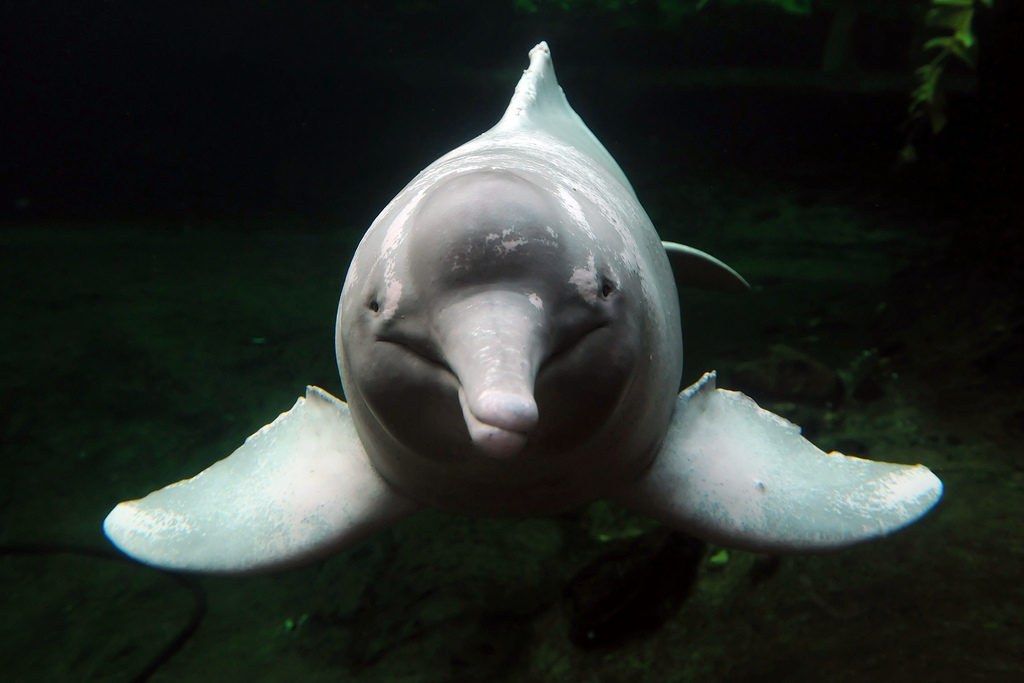
And what about their Conservation Status?
The species is listed in Appendix Ii of CITES (Convention on International Trade in Endangered Species of Wild Fauna and Flora).
It means that pinkish dolphins (along with other 21.000 species) are non necessarily threatened with extinction, but may go and then unless a strict regulation is enforced in order to protect the survival of the species in the wild.
Information technology is also listed in Appendix II of CMS meaning that they would significantly benefit from international co-performance regarding their conservation.
The Conservation Status is a classification organization that shows if a species still exists or how likely it is to get extinct in the near future.

The Pinkish dolphin is classified as Threatened (between Endangered and Vulnerable, due to lack of actual data)


All in all, the current state of affairs for the Pink Dolphin is worrying, with a high to very-high risk of extinction, more than coordinated efforts are withal needed for their preservation.
Other facts well-nigh Pink Dolphins
- The Boto or pink dolphin is subject to a item Amazon mythology. Information technology is said that this freshwater dolphin turns itself into a handsome human when the sun goes down. Some say it morphs itself fully clothed in white, some say with a harbinger lid, and another people say information technology takes the form of some other human from nearby villages. What for? To anesthetize and seduce unsuspecting your woman, impregnate them, and return to the river before the sun goes upward to turn back into pink dolphins. This is one of the well-nigh widespread Amazon rainforest myths, and some Amazon villagers attribute many of the single mom kids to this Amazon river dolphin. They fifty-fifty tell young girls to be careful virtually strangers and continue away from the river at night.
- Like most other dolphins, pink dolphins sleep with ane heart open. They tin do that past putting one one-half of their encephalon to sleep and keep the other side of the brain conscious and functioning. They alternate those sides to be able to rest and at the aforementioned time be on the lookout for predators.
- The season for giving nascency to young pink dolphins coincide with the flooding season of the Amazon river (betwixt May and June), providing an reward to female dolphins and their babies.
- Subsequently birth, information technology takes between 2-iii years for young pink dolphins to exist considered contained and adults.
- Concluding, but not to the lowest degree, pink dolphins are real. But in instance you were still wondering.
Wanna see some Pinkish Dolphins in the Amazon river?
Buckle up and set up for Run a risk!
See a broken link? Delight let the states know
Photo attributions:
(one) Cetacea range map Amazon River Dolphin past Pcb21 and Vardion / CC By-SA
(ii) Unknown/Pending attribution
(3) Amazonas-Flussdelfin Orinoko3 past Oceancetaceen / CC BY-SA
(4) Pucate_2015 07 27_0586 by Harvey Barrison / CC By-SA
(five) Boto vermelho past lubasi via VisualHunt / CC BY-SA
(six) Inia geoffrensis by Joachim Due south. Müller via Visual hunt / CC Past-NC-SA
(7) Conservation Status Ranking past Peter Halasz (Pengo) / CC Past
Source: https://www.amazonexperience.net/pink-dolphins-facts-and-information/
0 Response to "Does a Pink Dolpine Live in the Rainforest Jaguar Baby"
Postar um comentário